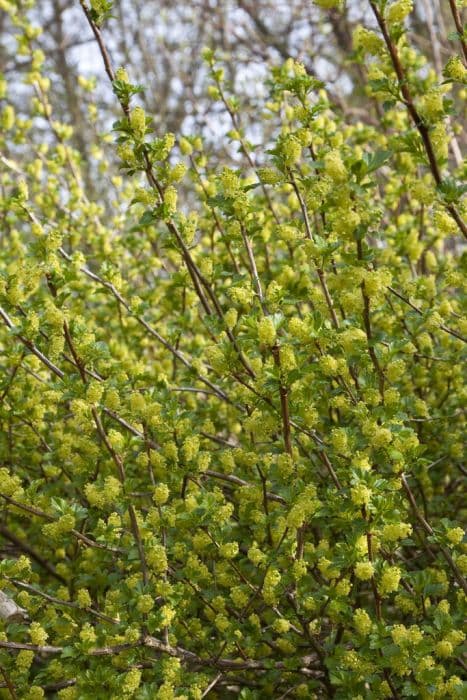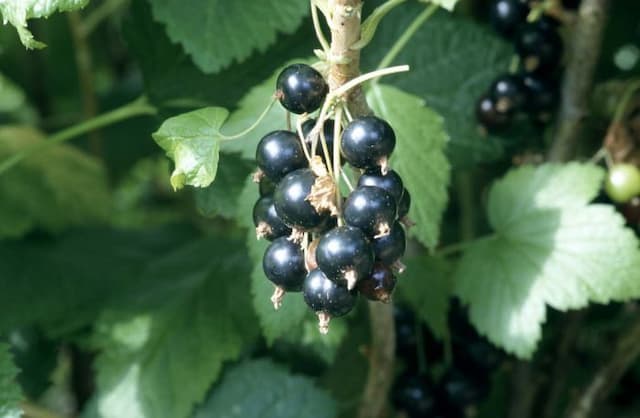Red Currant Ribes rubrum 'Junifer' (R)

ABOUT
The 'Junifer' variety of red currant is a deciduous shrub known for its clusters of bright red berries. The berries are typically small, juicy, and glimmer with a translucent quality. They hang from the branches in strings known as strigs, which can carry multiple berries. The plant's leaves are generally three-lobed, with a bright green color that contrasts starkly against the red fruit. During the flowering season, this shrub produces small, inconspicuous flowers that are usually a pale green or white color. The bark of the red currant 'Junifer' is smooth and may peel in thin layers. The overall appearance is that of a bushy plant with multiple stems and branches that bear both foliage and fruit. It is cultivated mainly for its fruit, which is popular for making jellies, jams, and desserts due to its tart flavor. The plant's appeal also lies in its ornamental qualities, with the berries providing a pop of color in the garden.
About this plant
 Names
NamesSynonyms
Red Currant, White Currant, Common Currant, Garden Currant.
Common names
Ribes rubrum 'Junifer'
 Toxicity
ToxicityTo humans
Ribes rubrum 'Junifer' is commonly known as red currant. This plant is not considered toxic to humans; in fact, its berries are edible and are often used in various culinary dishes. There are no common poisoning symptoms associated with the red currant, as it is generally safe to consume.
To pets
The red currant, Ribes rubrum 'Junifer', is not known to be toxic to pets. Its berries and other parts are not typically associated with poisoning in animals such as cats and dogs. Therefore, there are no specific symptoms or consequences related to the ingestion of this plant by pets. However, it is always recommended to watch for individual allergic reactions and consult a veterinarian if unusual symptoms appear after ingestion.
 Characteristics
CharacteristicsLife cycle
Perennials
Foliage type
Deciduous
Color of leaves
Green
Flower color
Greenish-white
Height
3-5 feet (0.9-1.5 meters)
Spread
3-5 feet (0.9-1.5 meters)
Plant type
Shrub
Hardiness zones
3-8
Native area
Europe
Benefits
 General Benefits
General Benefits- Edible Fruits: The plant produces red currants that are tangy and can be eaten fresh or used to make jellies, jams, and desserts.
- Attracts Wildlife: It provides food for birds and other wildlife, increasing biodiversity in the garden.
- Ornamental Value: With its attractive berries and foliage, it serves as an eye-catching addition to the landscape.
- Cold Hardy: It is capable of surviving in colder climates where other fruiting plants might not thrive.
- Low Maintenance: Once established, red currant plants generally require minimal care and are relatively easy to cultivate.
- Early Fruiting: It tends to produce fruit earlier in the season compared to some other fruit plants.
- High Yield: Red currant plants are known for their abundant fruit production.
- Adaptable: They can tolerate a range of soil types, as long as the soil is well-draining.
 Medical Properties
Medical Properties- Rich in Vitamin C: Red currant is known for its high vitamin C content, which can support the immune system.
- Antioxidant qualities: Contains antioxidants that may protect cells from damage caused by free radicals.
- Anti-inflammatory effects: Potential to reduce inflammation, although specific studies on Ribes rubrum 'Junifer' are limited.
- Digestive aid: The berries might help in digestion due to their fiber content.
 Air-purifying Qualities
Air-purifying QualitiesThis plant is not specifically known for air purifying qualities.
 Other Uses
Other Uses- Dye Production: The berries of the red currant, specifically the 'Junifer' variety, can be used to create natural dyes for fabric and food colorings, offering hues from pink to purple depending on the concentration.
- Insect Repellent: Crushed leaves of the red currant might be used as a natural insect repellent, offering a less harmful alternative to chemical repellents.
- Craft Material: The flexible branches of red currant plants can be woven into baskets or even used as the basis for wreaths and other decorative crafts.
- Garden Aesthetics: Red currant bushes can be trained to grow on a trellis or garden arch, adding structure and ornamental interest to garden designs.
- Photography: The vibrant red berries and lush green foliage can serve as an attractive backdrop or focal point for botanical photography.
- Bird Habitat: The dense foliage of the red currant bush provides nesting sites for birds, who may also feast on the berries.
- Landscape Design: Red currant bushes, with their attractive fruit and foliage, can be used in landscape planning for color contrasts or as a deciduous hedge in garden layouts.
- Culinary Garnish: Beyond being a food source, the berries and leaves of red currant can be used as an aesthetically pleasing garnish for a variety of dishes.
- Soil Improvement: When pruned, the leaves and branches of red currants can be added to compost heaps to enhance soil quality as they break down.
- Educational Tool: Red currant bushes can be used in educational horticulture programs to demonstrate fruit development, plant care, and propagation techniques.
Interesting Facts
 Feng Shui
Feng ShuiRed currant is not used in Feng Shui practice.
 Zodiac Sign Compitability
Zodiac Sign CompitabilityRed currant is not used in astrology practice.
 Plant Symbolism
Plant Symbolism- Prosperity and Abundance: Red currants, the fruit of Ribes rubrum 'Junifer', have been historically associated with wealth and plenty because of their numerous fruits clustered tightly on the branches, symbolizing an abundance of resources and wealth.
- Vitality and Good Health: The red currant is rich in vitamins and antioxidants, leading people to associate it with good health and a vibrant, energetic life.
- Home and Hearth: Cultivated in gardens and often associated with a bountiful harvest, the red currant is a symbol of a warm, well-provided home environment.
- Festivity and Celebration: Because of their bright color and association with summertime, red currants can symbolize joy, celebration, and the pleasures of life, often seen during festive occasions.
 Water
WaterRed currant plants like Ribes rubrum 'Junifer' should be watered thoroughly once a week, providing approximately 1 to 1.5 gallons of water per plant. During the growing season, if there is a lack of rain or during dry spells, increase watering to twice a week. Ensure that the soil is kept consistently moist but not waterlogged, as red currants are sensitive to over-watering. Water the plants at the base to avoid wetting the foliage, which can lead to fungal diseases. Decrease watering in the fall as the plant goes dormant.
 Light
LightRed currants prefer a location with full sun to partial shade. The ideal spot for Ribes rubrum 'Junifer' would receive about 4 to 6 hours of direct sunlight daily, with some afternoon shade in regions with intense summer heat. Avoid deep shade, as it will reduce fruit production and may promote fungal diseases due to less air circulation.
 Temperature
TemperatureRibes rubrum 'Junifer' grows best in a temperate climate with temperatures ranging from about 40 to 75 degrees Fahrenheit. They can survive winter temperatures down to around -40 degrees Fahrenheit and summer temperatures up to about 85 degrees Fahrenheit but may require protection during extreme heat. The ideal temperature range for red currants would be between 55 and 75 degrees Fahrenheit for optimal growth and fruiting.
 Pruning
PruningRibes rubrum 'Junifer' should be pruned to maintain good air circulation, allow light into the center of the plant, and promote healthy fruit production. Pruning is best done in late winter or early spring before new growth starts. Remove any dead, diseased, or crossing branches and thin out older stems to encourage new growth. Pruning every year will help maintain a productive framework and prevent the plant from becoming too congested.
 Cleaning
CleaningAs needed
 Soil
SoilRed currant 'Junifer' thrives best in well-draining soil with a mix of two-thirds loamy soil and one-third compost or well-rotted manure. The ideal pH for red currants is slightly acidic to neutral, ranging from 6.0 to 7.0.
 Repotting
RepottingRed currants like 'Junifer' typically do not need frequent repotting as they are most commonly grown outdoors. If grown in a container, repotting every 2-3 years or when the plant outgrows its pot is sufficient.
 Humidity & Misting
Humidity & MistingRed currants such as 'Junifer' are adaptable and do not require specific humidity conditions. Average outdoor humidity is usually sufficient for these plants.
 Suitable locations
Suitable locationsIndoor
Grow in bright light, cool room, high humidity.
Outdoor
Plant in full sun to partial shade, in well-drained soil.
Hardiness zone
3-7 USDA
 Life cycle
Life cycleRibes rubrum 'Junifer', commonly known as red currant 'Junifer', begins its life as a seed which, when planted in well-draining soil, will germinate in the presence of sufficient moisture and warmth. The seedling emerges and develops into a young plant with characteristic lobed leaves; it continues to mature and will typically establish a strong root system and woody stems within the first few years. As the plant enters its reproductive phase, typically in the second or third year, it produces small, greenish-white flowers in spring which are then pollinated by insects. After successful pollination, the flowers develop into clusters of translucent red berries that ripen during the summer, often in June or July—hence the cultivar name 'Junifer'. Once ripe, the berries can be harvested, and seeds within the berries can perpetuate the cycle if they find suitable conditions for germination. The plant, being perennial, will enter dormancy during the winter months, preserving its energy to begin the cycle anew come spring.
 Propogation
PropogationPropogation time
Spring to Summer
The most popular method of propagating Red Currant 'Junifer' is through hardwood cuttings. This technique is typically done in late fall after the leaves have dropped, or in winter when the plant is dormant. You would cut healthy, pencil-sized twigs from the current year's growth to about 6 to 8 inches (15 to 20 centimeters) long, making sure each cutting has at least two or three buds. The lower end of the cutting should be snipped just below a bud, and the top just above a bud to maximize potential growth. The cuttings can then be planted directly into the ground or into pots with the lower two-thirds of their length buried in a mix of soil and compost. To improve success rates, the cutting bases can be dipped in rooting hormone powder before planting. The cuttings typically root over the winter, and by spring they should begin to grow as new plants.








